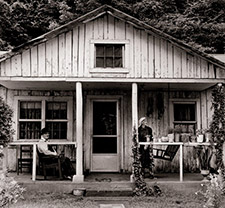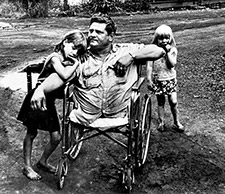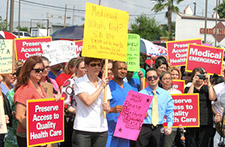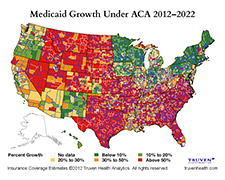Medicaid
The nation’s largest health program in terms of recipients is Medicaid. Enacted in 1964, it serves 60 million people.
Medicaid, designed to provide health care to the needy, is jointly financed by the federal government and the states, with Washington paying 50 percent of the costs in higher-income states and about 70 percent in lower-income states. States have historically had leeway to define eligibility and benefits within guidelines set by federal law. Although the aim of the program is to help the needy, a significant number of middle and upper class families arrange to have their elderly parents receive medicaid.
 Retired miner George Johnson sits on his sister’s porch in Mingo county West Virginia. Builder Levy, 1972
Retired miner George Johnson sits on his sister’s porch in Mingo county West Virginia. Builder Levy, 1972The largest number of people served are young, but the largest percent of funds go to the elderly. According to the Congressional Budget Office, in the 2010 fiscal year, 77 percent of people enrolled in Medicaid were children and families, while 23 percent were elderly or disabled. But 64 percent of Medicaid spending was for older Americans and people with disabilities, while 36 percent went to children and families.
For low-income children and their parents, Medicaid pays for essential and preventive health care services that these families could otherwise not afford. Medicaid also provides payments for nursing home care and helps millions of families with the cost of home-based long-term care. Any reduction will jeopardize all of these benefits.
However, Medicaid is not simply health care for the poor. It enables hospitals to function, including subsidized training for doctors. For example, approximately one-third of NY State’s health care expenditures derive from Medicaid.
Medicaid is a target for spending cuts because it is the second largest item in most states’ budgets, after elementary and secondary education.
 Grief, love and concern for his children are reflected in this 1971 image of disabled coal miner Jack Smith. The photo was taken in West Virginia, where it is only too well known that coal mining is one of the most dangerous occupations in the world. Don Stillman, 1971
Grief, love and concern for his children are reflected in this 1971 image of disabled coal miner Jack Smith. The photo was taken in West Virginia, where it is only too well known that coal mining is one of the most dangerous occupations in the world. Don Stillman, 1971The Patient Protection and Affordable Care (ACA) act provides for a vast expansion of Medicaid to cover about half the nation’s uninsured. An additional 35 million will still be uninsured. In June 2012, the Supreme Court upheld but limited Medicaid provisions of the health care law. States are not required to participate in the exchanges the law authorizes to facilitate selection of low cost medical care.
Some states insist that exchanges operate through private companies where doctors, support staff and other parts of our fee for service health care system mix larger profits into operations, propping up a health care system in crisis on the backs of the needy. These practices are neither transparent nor direct.
Proposals to Change Medicaid
Opponents reject the substantial expansion provided under ACA and some states suggest that they will not participate either in the entire program or efforts to organize and operate the exchanges which the Act provides. Others point out that states accessing federal Medicaid dollars stimulate their own economies many-fold by way of the multiplier effect resulting from economic activity.

